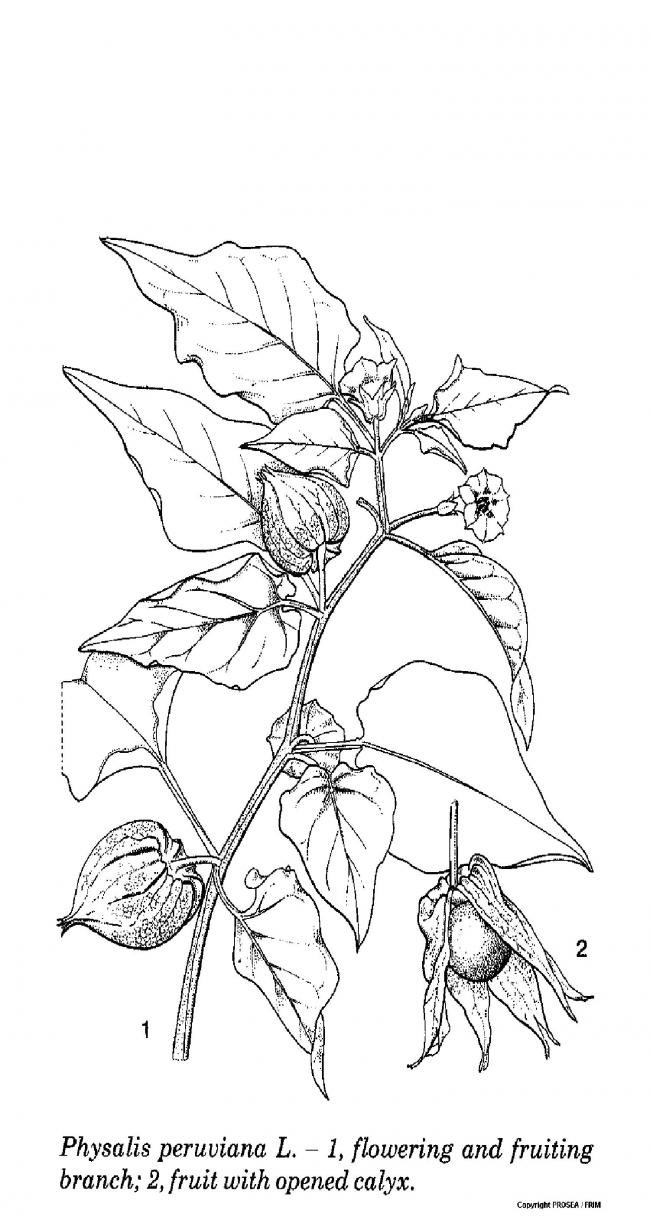Scientific Name
Physalis peruviana L.
Synonyms
Alkekengi pubescens Moench, Boberella peruviana (L.) E.H.L.Krause, Physalis esculenta Salisb,. Physalis latifolia Lam., Physalis tomentosa Medik. [1]
Vernacular Name
| English | Cape gooseberry [2], Barbados gooseberry, cherry tomato, gooseberry tomato, ground cherry, husk tomato, love apple poha, Peruvian cherry, Peruvian ground cherry, purple ground cherry, strawberry tomato, wild gooseberry, winter cherry [3] |
| China | Deng long guo [3], deng long cao, suan jiang cao, xiao guo suan jiang [4] |
| India | Kila shi, makoya, malathakkali keera, tholthakolli, tipari [3] |
| Indonesia | Ceplukan, cecendet badak [2][3] |
| Thailand | Gusboeri (Bangkok) [2][3] |
| Philippines | Lobo-lobohan [2][3] |
| Nepal | Jangali mewa, Jungali mewa, rasbharee [3] |
| Japan | Budô-hôzuki, ke-hôzuki [3] |
| Kenya | Nathi, ngavu, nyakonglo, nyatonglo, olnasi, otonglo, tabaako [3] |
| Southern Africa | Appelderliefde, geel appelliefie, appelliefie, Kaapse, pampelmoertjie, pompelmoesie [3] |
| Arab | Hhabwah, hhashîsh sakrân [4] |
| Germany | Ananaskirsche, capische stachelberre, essbare judaskirsche, judenkirsche, kap-stachelbeere, kapstachelbeere, peruanische schlutte [4] |
| Italy | Alchechenge giallo, alchechengi giallo, alchechenge grosso commestible, capulé, fisalis, vescicaria [4] |
| Brazil | Bate testa, camapú [3] |
| Mexico | Niltomate, tomate, tomate de cascara [3] |
| Hawaii | Pa’ina, poha [3] |
Geographical Distributions
Physalis peruviana occurs naturally in the Peruvian and Chilean highlands. During the last 200 years, it has been cultivated and become widely naturalised elsewhere in tropical highlands. It is also grown in the subtropics and in mild temperate areas. P. peruviana is common in Southeast Asia, but not cultivated much. In Indonesia, plants are found at altitudes ranging from 700-2300 m. [2]
Botanical Description
P. peruviana is a member of the Solanaceae family. It is a perennial herb, 0.5-2 m tall, with purplish, ribbed, spreading branches and creeping rootstock and densely hairy. [2]
The leaves are subopposite, ovate, measuring 5-15 cm x 4-10 cm, cordate at base, acuminate at apex, and entirely or shallowly toothed while the petioles are as long as the blades. [2]
The flowers are solitary, pendent and axillary. The pedicel is 1 cm long and longer in fruit. The sepal is 5-toothed. The petal is 2 cm in diametre, slightly 5-lobed, yellow with 5 large dark brown-purple spots within while the anthers are purple. The stigma is subcapitate. [2]
The fruit is a spherical berry, 1-2 cm in diametre, orange-yellow, smooth, enclosed in the densely hairy, ovoid and inflated bladdery sepal (husk). The pulp is juicy while the seeds are numerous, yellowish and very small. [2]
Cultivation
The ecological requirements for P. peruviana are similar to those of tomato, but the temperature range appears to be somewhat cooler: the plants are not killed by slight frost. They also flower and fruit best in fairly cool weather; high temperatures are detrimental to flowering and fruiting. Hence, in areas with a seasonal climate (also in the subtropics), the crop is timed to fruit in the cool season. Even the plants in Indonesia can be found at altitudes ranging from 700-2300 m, but the crop grows best above 1500 m. The overcast skies in many highlands and the shades of open forests in naturalised stands suggest its tolerance to low light levels, but fruiting seems to be best in full light. Ample rain and rich alluvial soil lead to lush growth and delayed fruiting. The fruit is spoiled if wet conditions prevail during the harvest season. The moisture stress can impose dormancy. The well-drained sandy loams with good organic matter content are preferred. [2]
Chemical Constituent
No documentation.
Plant Part Used
No documentation.
Traditional Use
No documentation.
Preclinical Data
No documentation.
Clinical Data
No documentation.
Poisonous Management
No documentation.
Line Drawing

References
- The Plant List. Ver 1.1. Physalis peruviana L.[homepage on the Internet]. c2013 [updated 2010 Apr 18; cited 2015 Jul 28]. Available from: http://www.theplantlist.org/tpl1.1/record/kew-2549655
- Verhoeven G. Physalis peruviana L. In: Verheij EWM, Coronel RE, editors. Plant Resources of South-East Asia No. 2: Edible fruits and nuts. Wageningen, Netherlands: Pudoc, 1991; p. 254-256.
- Quattrocchi U. CRC world dictionary of medicinal and poisonous plants: Common names, scientific names, eponyms, synonyms, and etymology. Volume IV M-Q. Boca Raton, Florida: CRC Press; 2012. p. 553-554.
- Philippine Medicinal Plants. Lobo-lobohan. Physalis peruviana Linn. [homepage on the Internet]. [updated 2014 Mar; cited 2015 Aug 18] Available from: http://www.stuartxchange.com/Lobo-lobohan.html


